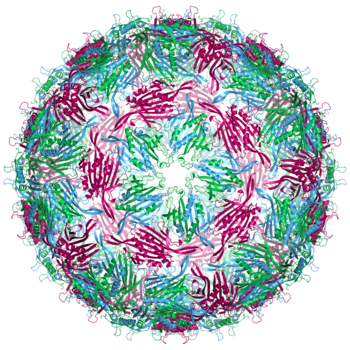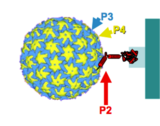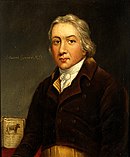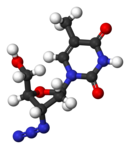Portal:Viruses
Welcome!
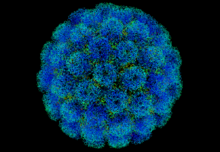
Viruses are small infectious agents that can replicate only inside the living cells of an organism. Viruses infect all forms of life, including animals, plants, fungi, bacteria and archaea. They are found in almost every ecosystem on Earth and are the most abundant type of biological entity, with millions of different types, although only about 6,000 viruses have been described in detail. Some viruses cause disease in humans, and others are responsible for economically important diseases of livestock and crops.
Virus particles (known as virions) consist of genetic material, which can be either DNA or RNA, wrapped in a protein coat called the capsid; some viruses also have an outer lipid envelope. The capsid can take simple helical or icosahedral forms, or more complex structures. The average virus is about 1/100 the size of the average bacterium, and most are too small to be seen directly with an optical microscope.
The origins of viruses are unclear: some may have evolved from plasmids, others from bacteria. Viruses are sometimes considered to be a life form, because they carry genetic material, reproduce and evolve through natural selection. However they lack key characteristics (such as cell structure) that are generally considered necessary to count as life. Because they possess some but not all such qualities, viruses have been described as "organisms at the edge of life".
Measles is a disease that only affects humans caused by the measles virus, an RNA virus in the Paramyxoviridae family. It is highly contagious, with transmission occurring via the respiratory route or by contact with secretions. Symptoms generally develop 10–12 days after exposure and last 7–10 days; they include high fever, cough, rhinitis and conjunctivitis, white Koplik's spots inside the mouth and a generalised red maculopapular rash. Complications including diarrhoea, otitis media and pneumonia are relatively common; more rarely seizures, encephalitis, croup, corneal ulceration and blindness can occur. The risk of death is usually around 0.2%, but may be as high as 10–28% in areas with high levels of malnutrition and poor healthcare.
Measles was first described by Rhazes (860–932). The disease is estimated to have killed around 200 million people between 1855 and 2005. It affects about 20 million people a year, primarily in the developing areas of Africa and Asia, and is one of the leading vaccine-preventable disease causes of death. No antiviral drug is licensed. An effective measles vaccine is available, but uptake has been reduced by anti-vaccination campaigns, particularly the fraudulent claim that the MMR vaccine might be associated with autism. Rates of disease and deaths increased from 2017 to 2019, attributed to a decrease in immunisation.
The MS2 bacteriophage was the first virus genome to be sequenced in 1976. Its capsid has an icosahedral structure made up from 180 copies of the coat protein.
Credit: Neil Ranson (7 June 2011)
26 February: In the ongoing pandemic of severe acute respiratory syndrome coronavirus 2 (SARS-CoV-2), more than 110 million confirmed cases, including 2.5 million deaths, have been documented globally since the outbreak began in December 2019. WHO
18 February: Seven asymptomatic cases of avian influenza A subtype H5N8, the first documented H5N8 cases in humans, are reported in Astrakhan Oblast, Russia, after more than 100,0000 hens died on a poultry farm in December. WHO
14 February: Seven cases of Ebola virus disease are reported in Gouécké, south-east Guinea. WHO
7 February: A case of Ebola virus disease is detected in North Kivu Province of the Democratic Republic of the Congo. WHO
4 February: An outbreak of Rift Valley fever is ongoing in Kenya, with 32 human cases, including 11 deaths, since the outbreak started in November. WHO
21 November: The US Food and Drug Administration (FDA) gives emergency-use authorisation to casirivimab/imdevimab, a combination monoclonal antibody (mAb) therapy for non-hospitalised people twelve years and over with mild-to-moderate COVID-19, after granting emergency-use authorisation to the single mAb bamlanivimab earlier in the month. FDA 1, 2
18 November: The outbreak of Ebola virus disease in Équateur Province, Democratic Republic of the Congo, which started in June, has been declared over; a total of 130 cases were recorded, with 55 deaths. UN
A prion is an infectious agent hypothesised to consist of protein. This is in contrast to viruses and other known infectious agents, which all contain one or both of the nucleic acids, DNA and RNA. Prions propagate by transmitting a misfolded protein state. The prion induces existing, properly folded proteins in the host to convert into the misfolded prion form. Abnormal protein aggregates called amyloids accumulate in infected tissue and are associated with tissue damage and cell death.
Prion variants of PrP are associated with the transmissible spongiform encephalopathies in mammals. Human prion diseases include Creutzfeldt–Jakob disease, Gerstmann–Sträussler–Scheinker syndrome, fatal familial insomnia, kuru and variably protease-sensitive prionopathy. Prion diseases of other mammals include bovine spongiform encephalopathy ("mad cow disease") in cattle, scrapie in sheep, and chronic wasting disease in deer. All known mammalian prion diseases affect the structure of the brain or other neural tissue. All are progressive, lack an effective treatment and are inevitably fatal. Proteins showing prion-type behaviour are also found in some fungi. Fungal prions do not appear to cause disease in their hosts.
The 1993 hantavirus outbreak in the Four Corners region of southwest USA was of a novel hantavirus, subsequently named Sin Nombre virus. It caused the previously unrecognised hantavirus pulmonary syndrome – the first time that a hantavirus had been associated with respiratory symptoms. Mild flu-like symptoms were followed by the sudden onset of pulmonary oedema, which was fatal in half of those affected. A total of 24 cases were reported in April–May 1993, with many of those affected being from the Navajo Nation territory. Hantavirus infection of humans generally occurs by inhaling aerosolised urine and faeces of rodents, in this case the deer mouse (Peromyscus; pictured).
Previously documented hantavirus disease had been confined to Asia and Europe, and these were the first human cases to be recognised in the USA. Subsequent investigation revealed undiagnosed cases dating back to 1959, and Navajo people recalled similar outbreaks in 1918, 1933 and 1934.
| “ | Viruses are living chemicals... | ” |
Viruses & Subviral agents: bat virome • elephant endotheliotropic herpesvirus • HIV • introduction to viruses![]() • Playa de Oro virus • poliovirus • prion • rotavirus
• Playa de Oro virus • poliovirus • prion • rotavirus![]() • virus
• virus![]()
Diseases: colony collapse disorder • common cold • croup • dengue fever![]() • gastroenteritis • Guillain–Barré syndrome • hepatitis B • hepatitis C • hepatitis E • herpes simplex • HIV/AIDS • influenza
• gastroenteritis • Guillain–Barré syndrome • hepatitis B • hepatitis C • hepatitis E • herpes simplex • HIV/AIDS • influenza![]() • meningitis
• meningitis![]() • myxomatosis • polio
• myxomatosis • polio![]() • pneumonia • shingles • smallpox
• pneumonia • shingles • smallpox
Epidemiology & Interventions: 2007 Bernard Matthews H5N1 outbreak • Coalition for Epidemic Preparedness Innovations • Disease X • 2009 flu pandemic • HIV/AIDS in Malawi • polio vaccine • Spanish flu • West African Ebola virus epidemic
Virus–Host interactions: antibody • host • immune system![]() • parasitism • RNA interference
• parasitism • RNA interference![]()
Methodology: metagenomics
Social & Media: And the Band Played On • Contagion • "Flu Season" • Frank's Cock![]() • Race Against Time: Searching for Hope in AIDS-Ravaged Africa
• Race Against Time: Searching for Hope in AIDS-Ravaged Africa![]() • social history of viruses
• social history of viruses![]() • "Steve Burdick" • "The Time Is Now" • "What Lies Below"
• "Steve Burdick" • "The Time Is Now" • "What Lies Below"
People: Brownie Mary • Macfarlane Burnet![]() • Bobbi Campbell • Aniru Conteh • people with hepatitis C
• Bobbi Campbell • Aniru Conteh • people with hepatitis C![]() • HIV-positive people
• HIV-positive people![]() • Bette Korber • Henrietta Lacks • Linda Laubenstein • Barbara McClintock
• Bette Korber • Henrietta Lacks • Linda Laubenstein • Barbara McClintock![]() • poliomyelitis survivors
• poliomyelitis survivors![]() • Joseph Sonnabend • Eli Todd • Ryan White
• Joseph Sonnabend • Eli Todd • Ryan White![]()
Cauliflower mosaic virus (CaMV) is a plant pararetrovirus in the Caulimoviridae family, which has similarities with hepadnaviruses such as hepatitis B virus. It predominantly infects members of the Brassicaceae (cabbage) family, including cauliflower and turnip; some strains can also infect Datura and Nicotiana species of the Solanaceae family. It is transmitted by aphid vectors, such as Myzus persicae. Symptoms include a mottled leaf pattern called "mosaic", necrotic lesions on the surface of infected leaves, stunted growth and deformation of the overall plant structure.
Although the viral genome is double-stranded DNA, the virus replicates via reverse transcription like a retrovirus. The icosahedral virion is 52 nm in diameter, and is built from 420 capsid protein subunits. The circular 8 kb genome encodes seven proteins, including a movement protein, which facilitates viral movement to neighbouring cells, and an insect transmission factor, which recognises a protein receptor at the tip of the aphid mouthparts (pictured). CaMV has several ways of evading the host defensive responses, which include interrupting salicylic acid-dependent signalling and decoying host silencing machinery. The virus has a strong constitutive (always on) promoter, CaMV 35S, which is widely used in plant genetic engineering.
- ...that Australian pilot and nurse Robin Miller (monument pictured) borrowed money to buy a Cessna 182 and flew to remote outback areas in Western Australia to vaccinate Indigenous Australian children against polio, becoming known as the "Sugarbird Lady"?
- ...that the Mokola virus is a relative of the rabies virus and was first isolated in tree shrews?
- ...that in 1995–97, a Centers for Disease Control program identified over a hundred patients likely suffering from life-threatening infections new in the history of emerging infectious diseases?
- ...that Batheay District in Kampong Cham Province, Cambodia, was the site of an outbreak of the deadly H5N1 virus in 2006?
- ...that Fig Trees, an operatic documentary about AIDS activism, is narrated by a singing albino squirrel?
Edward Jenner (1749–1823) was an English physician and scientist who pioneered the smallpox vaccine, the world's first vaccine. Noting the common observation that milkmaids were generally immune to smallpox, Jenner postulated that the pus in the blisters that milkmaids received from cowpox (a similar but much less virulent disease) protected them from smallpox. In 1796, Jenner tested his hypothesis by inoculating an eight-year-old boy with pus from an infected milkmaid. He subsequently repeatedly challenged the boy with variolous material, then the standard method of immunisation, without inducing disease. He published a paper including 23 cases in 1798. Although several others had previously inoculated subjects with cowpox, Jenner was the first to show that the procedure induced immunity to smallpox. He later successfully popularised cowpox vaccination.
Jenner is often called "the father of immunology", and his work is said to have saved more lives than that of any other individual.
1 August 1971: The term viroid was coined by Theodor Diener to describe the agent of potato spindle tuber disease
6 August 2007: Maraviroc, first CCR5 receptor antagonist, approved for HIV/AIDS
8 August 2011: UN declared rinderpest eradicated
8 August 2014: WHO declared the Ebola outbreak in West Africa (virus pictured), the most widespread so far, an international public health emergency
18 August 1990: Ryan White Care Act enacted, the largest American federally funded programme for people living with HIV/AIDS
20 August 1780: Start of an outbreak of dengue fever in Philadelphia, USA, which led Benjamin Rush to describe the disease in 1789
26 August 1976: First case of Ebola virus, now the Zaire form
26 August 1998: Fomivirsen, first antisense drug, approved for cytomegalovirus retinitis
Zidovudine (ZDV) (also known as AZT and sold as Retrovir) is an antiretroviral drug used in the prevention and treatment of HIV/AIDS. Classed as a nucleoside analogue reverse-transcriptase inhibitor, it inhibits HIV's reverse transcriptase enzyme, which copies the viral RNA into DNA and is essential for its replication. The first breakthrough in AIDS therapy, ZDV was licensed in 1987. While it significantly reduces HIV replication, leading to some clinical and immunological benefits, when used alone ZDV does not completely stop replication, allowing the virus to become resistant to it. The drug is therefore used together with other anti-HIV drugs in combination therapy called highly active antiretroviral therapy. To simplify its administration, ZDV is included in combination pills with lamivudine (Combivir) and lamivudine plus abacavir (Trizivir). ZDV continues to be used to prevent HIV transmission from mother to child during childbirth; it was previously part of the standard post-exposure prophylaxis after needlestick injury.
Subcategories of virology:
- Comment on what you like and dislike about this portal
- Join the Viruses WikiProject
- Tag articles on viruses and virology with the project banner by adding {{WikiProject Viruses}} to the talk page
- Assess unassessed articles against the project standards
- Create requested pages: red-linked viruses | red-linked virus genera
- Expand a virus stub into a full article, adding images, citations, references and taxoboxes, following the project guidelines
- Create a new article (or expand an old one 5-fold) and nominate it for the main page Did You Know? section
- Improve a B-class article and nominate it for Good Article
 or Featured Article
or Featured Article status
status - Suggest articles, pictures, interesting facts, events and news to be featured here on the portal
 WikiProject Viruses
Related WikiProjects
WikiProject Viruses
Related WikiProjects
Medicine • Microbiology • Molecular & Cellular Biology • Veterinary Medicine
Related PortalsThe following Wikimedia Foundation sister projects provide more on this subject:
-
Commons
Free media repository -
Wikibooks
Free textbooks and manuals -
Wikidata
Free knowledge base -
Wikinews
Free-content news -
Wikiquote
Collection of quotations -
Wikisource
Free-content library -
Wikispecies
Directory of species -
Wikiversity
Free learning tools -
Wiktionary
Dictionary and thesaurus

